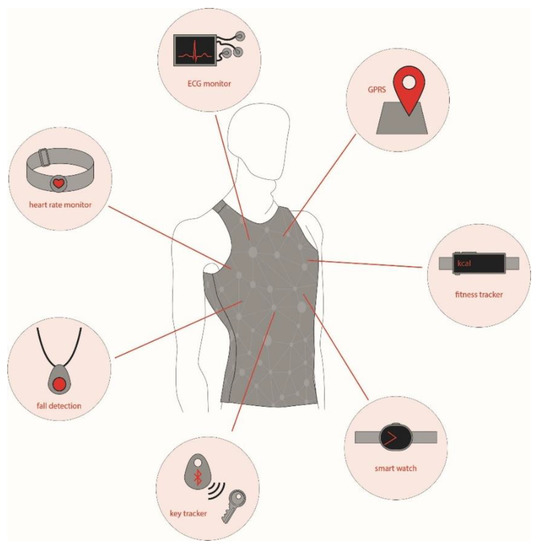- smart garments
- e-textiles
- biosignals
- sensors
- dry electrode
- signal-to-noise ratio (SNR)
- Internet of Things (IoT)
- knitted fabrics
The electrical, chemical, and mechanical activities that take place in the human body during any biological event, such as beating of the heart and contraction of muscles, produce different biomedical signals [1]. On the basis of the physiological origins of these biosignals, they can be grouped as bioelectrical, biomagnetic, biochemical, biomechanical, bioacoustics, bio-optical, and biothermal signals. They can be further classified based on their nature of existence, that is, permanent or induced biosignals [2]. Permanent signals exist at all times within the body and are generated without any artificial trigger, impact, or excitation from outside of the body, for example, electrocardiogram (ECG) signal. Induced biosignals are artificially triggered, excited, or induced and they exist roughly for the duration of the excitation, for example, electroretinogram (ERG). Sensors that can sense biosignals or biopotentials can be categorised as physical, electrical, or chemical depending on their specific applications [1]. Different kinds of specialised electrodes are used for capturing biosignals. These electrodes could be either non-invasive (placed on skin surface) or invasive (e.g., microelectrodes or wire electrodes). Adding electrodes and sensors onto textiles and garments is a non-evasive way of capturing and measuring biosignals.
Thanks to the advancement of technology in producing microelectromechanical systems (MEMSs), wearable electronics have become very common consumables on the market nowadays. Wrist-worn wearable devices (smart watches and fitness trackers) experienced a growth of 18% and 7% in the United Kindom during the period of 2016–2017 and 2017–2018, respectively [3]. With the advent of conductive threads, textile structures either woven or knitted from conductive yarns, and conductive print-inks including those from graphene, it is now possible to produce or integrate light-weight sensors onto textiles to monitor health, fitness, and performance in a non-clinical environment, in daily-life, and in sport-training conditions [4–7]. An overview of the recent developments in wearable sensors for remote health monitoring is presented by Majumder et al. [8], while the smart sensors and fusion systems for sports and biomedical applications are reviewed by Mendes Jr. et al. [9]. In some cases, smart sensors are worn directly on the body using belts, straps, and adhesives; and in some cases, they are integrated or pocketed within textiles. The concept of Wearable 2.0 [10] envisages a full integration of wearable electronics within clothing, as presented in the Figure 1. Traditionally, such systems are known as smart garments, e-textiles, and e-garments. In the literature, they have also been mentioned as the IoT (Internet of Things) smart garments system [11]. For the ease of understanding across all disciplines, we have referred to them as smart electro-clothing systems (SeCSs) in this review.
A good number of SeCSs have emerged onto the market. This paper reviews the state-of-the-art development in design, construction, functionality, and application of such systems. As far as is known, such a review on SeCSs covering these relevant issues has not been presented before. However, it is important for researchers and product developers to have a complete review of those before initiating new research and attempting new product development in this and associated fields.

Figure 1. Concept of Wearable 2.0. ECG, electrocardiogram.
This entry is adapted from the peer-reviewed paper 10.3390/s20030587
